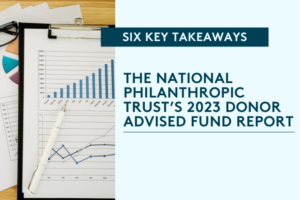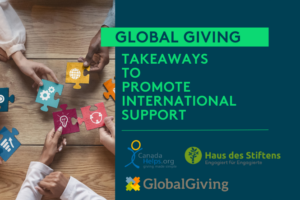Maximize Your Mission: 8 Ways Nonprofits Can Harness Donor-Advised Funds for Success

November 30, 2023 | 5 min read
Leveraging donor-advised funds (DAFs) can play an important role in expanding a nonprofit’s donor base and working toward its core mission. DAFs can offer key resources such as connecting nonprofits with workplace giving programs, showcasing its mission to new potential donors, providing key insights into donor activity and preferences, increasing a donation’s impact, and driving charitable giving for years to come. Nonprofits can use donor-advised funds to streamline fundraising efforts so they can devote more time to working toward their core mission. By leveraging DAFs properly, nonprofits can maximize their impact and make a tangible difference in the community they serve.
Read on for eight strategies to leverage donor-advised fund donors to advance your mission.
- RELATIONSHIPS. Building relationships with donor-advised fund donors is crucial for nonprofits to secure ongoing support. Communicating regularly, providing updates on the impact your organization is making in the community, and expressing gratitude for their support will go a long way in developing meaningful relationships. This will not only deepen the donor’s connection to your mission but also increase the likelihood of receiving recurring donations.
- GET PERSONAL. Donors who regularly give to nonprofits do so because they believe in the nonprofit’s mission and goals. Using personalized engagement strategies, nonprofits can encourage donors to support their ongoing projects and initiatives and create a feeling of empowerment that a donor’s contributions are making measurable impacts. This can provide a significant source of continued funding and increase donor engagement and commitment.
-
EDUCATE. Donors who feel connected to the projects they support through their donations are more likely to become long-term partners, ensuring more sustainable funding for nonprofits. Many donors may not be aware of the full potential of their donations, so regularly communicating the ways donations are used to advance your mission, such as supporting specific programs or ongoing initiatives, can help donors see the direct impact they are making. Helping donors understand the change they are supporting can inspire larger and more strategic contributions.
- BUSINESS CONNECTIONS. Company relationships are valuable to nonprofits because they often have a large base of potential donors and can help promote your nonprofit’s mission through internal programming. Many workplace giving programs utilize donor-advised funds to support their corporate giving programs. If you understand a company is supporting you through these types of programs, consider planning a fundraising or volunteer events tailored to that company. Creating opportunities and messaging for companies and their employees can help them see how much you value their support and encourage them to become long-term donors and supporters.
- MAXIMIZE MATCHING GIFTS. Encourage donors with access to corporate giving programs to leverage matching gift programs their employer offers. These programs can almost double the impact of the employee contribution, which can motivate donors to give more. Clearly communicate the availability and benefits of matching gift programs so donors are aware of this additional opportunity to support your nonprofit.
-
UNDERSTAND CSR AND ESG GOALS. When you understand a business’s corporate social responsibility (CSR) and environmental, social, and governance (ESG) goals, you can better understand how to engage with the business to align your nonprofit with the company’s values. When nonprofits understand giving priorities and guidelines of businesses they want to partner with, they can tailor proposals and funding requests to coincide with the business’ goals. This can lead to significant contributions and ongoing support.
- CREATE PERSONALIZED GIVING OPPORTUNITIES. Customize giving opportunities based on donor interests and behaviors. Use your CRM to understand each donor-advised fund donor’s preference for how and when they prefer to give or the specific programs or initiatives they support. With that information, tailor your outreach and donation requests to mirror their preferences so they feel more inclined to support your cause. Providing donors with personalized options allows them to feel more connected to your mission and encourages ongoing contributions.
- TELL YOUR STORY. Platforms, such as NPOconnect, that are designed to support workplace giving programs should be fully utilized so nonprofits can reach the millions of potential donors that use the platform and have access to the yearly estimated $5 billion in workplace giving contributions. One of the most impactful ways to encourage donations is through storytelling. Pulling at heartstrings and showcasing the value of your mission in a creative and thoughtful way can go a long way in encouraging people to support your organization and help you achieve your goals. Using real examples, testimonials, and pictures can showcase the value of your nonprofit to potential donors and encourage them to support your mission.
Donor-advised funds can be a powerful tool for nonprofits to maximize their mission and drive positive change in their communities. By harnessing the power of donor-advised funds, nonprofits can make a tangible difference in the world and achieve their goals in advancing their mission.
To learn more about The Blackbaud Giving Fund, visit blackbaudgivingfund.org, or follow the organization on LinkedIn, Facebook, and Instagram for updates, news, and more.
For more information about NPOconnect or to sign up, visit https://nonprofit.yourcause.com/login/create-account.


